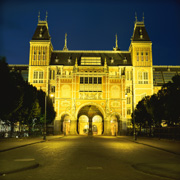Amsterdam History
| During the 12th century, a fishing
village arose out of Amsterdam’s early swamplands. At
some point, someone discovered that the IJ inlet provided access
to rich fishing waters. Shortly after, eager fisherman began
building huts on small islands around the area. The first dams
were built during this time. The region remained sparsely populated
until 1275 when the Count of Holland granted free trade rights
in Holland and Zeeland. This is generally accepted as the day
Amsterdam was founded. |
Trade between Germany and Baltic port towns began and Amsterdam steadily
grew. During the 1300’s, beer became the major source of income.
Tolls were placed on the import and export of beer. Then in late 16th
century after Antwerp was invaded by Spain, Amsterdam took on a new
role in the region.
 Merchants and craftsmen fled to Amsterdam taking with them the
diamond industry in addition to their merchant skills. The 17th
century marked the beginning of Amsterdam’s Golden Age, which
endured for over 70 years. Out of this came the Verenizde Oostindische
Campangnie (V.O.C.) otherwise known as the United East India Company.
The V.O.C. was granted a monopoly on trade in the east. Wealth flowed
into Amsterdam in the city exploded. Luxurious mansions were built
along with churches, and an enhanced canal system. Architects and
artists flourished. When the French invaded the United Provinces
and in 1672, the economic boom came to a screeching halt. The Dutch
call this the Year of Disaster. War with France, England, and later
with Spain during the War of Spanish Succession devastated the region.
Dutch wealth that remained was channeled elsewhere into safer investments.
Amsterdam fell into a downward spin for many years. By 1791 the
United East India Company went out of business. Merchants and craftsmen fled to Amsterdam taking with them the
diamond industry in addition to their merchant skills. The 17th
century marked the beginning of Amsterdam’s Golden Age, which
endured for over 70 years. Out of this came the Verenizde Oostindische
Campangnie (V.O.C.) otherwise known as the United East India Company.
The V.O.C. was granted a monopoly on trade in the east. Wealth flowed
into Amsterdam in the city exploded. Luxurious mansions were built
along with churches, and an enhanced canal system. Architects and
artists flourished. When the French invaded the United Provinces
and in 1672, the economic boom came to a screeching halt. The Dutch
call this the Year of Disaster. War with France, England, and later
with Spain during the War of Spanish Succession devastated the region.
Dutch wealth that remained was channeled elsewhere into safer investments.
Amsterdam fell into a downward spin for many years. By 1791 the
United East India Company went out of business.
In 1794, French invaded Holland and captured Amsterdam. Napoleon
appointed a monarch. French occupancy was short lived. The Dutch
reclaimed Amsterdam and inaugurated a new monarch, William of Orange,
in 1815.
In 1839, Amsterdam’s first railway was opened. During Europe’s
industrial revolution, Amsterdam’s canal links to the North
Sea and Rhine River coupled with the railway sparked an economic
boom. Amsterdam became known for its diamond industry.
Germany invaded Amsterdam on May 10th 1940. Amsterdam put up little
resistance. As with most European countries, Hitler gained a following
in the Netherlands. However, there was unrest over Nazi treatment
of Jews. On May 5th 1945 the Allied forces liberated the Netherlands.
Today Amsterdam is a bustling village city with a multi-cultural
population. Amsterdam is recognized for it’s liberal views,
vibrant nightlife, unique merchant shops, and world-class museums.
Wealth and prosperity has been restored to Amsterdam and all it’s
historic charm.
More Information
 www.state.gov www.state.gov
|

 Merchants and craftsmen fled to Amsterdam taking with them the
diamond industry in addition to their merchant skills. The 17th
century marked the beginning of Amsterdam’s Golden Age, which
endured for over 70 years. Out of this came the Verenizde Oostindische
Campangnie (V.O.C.) otherwise known as the United East India Company.
The V.O.C. was granted a monopoly on trade in the east. Wealth flowed
into Amsterdam in the city exploded. Luxurious mansions were built
along with churches, and an enhanced canal system. Architects and
artists flourished. When the French invaded the United Provinces
and in 1672, the economic boom came to a screeching halt. The Dutch
call this the Year of Disaster. War with France, England, and later
with Spain during the War of Spanish Succession devastated the region.
Dutch wealth that remained was channeled elsewhere into safer investments.
Amsterdam fell into a downward spin for many years. By 1791 the
United East India Company went out of business.
Merchants and craftsmen fled to Amsterdam taking with them the
diamond industry in addition to their merchant skills. The 17th
century marked the beginning of Amsterdam’s Golden Age, which
endured for over 70 years. Out of this came the Verenizde Oostindische
Campangnie (V.O.C.) otherwise known as the United East India Company.
The V.O.C. was granted a monopoly on trade in the east. Wealth flowed
into Amsterdam in the city exploded. Luxurious mansions were built
along with churches, and an enhanced canal system. Architects and
artists flourished. When the French invaded the United Provinces
and in 1672, the economic boom came to a screeching halt. The Dutch
call this the Year of Disaster. War with France, England, and later
with Spain during the War of Spanish Succession devastated the region.
Dutch wealth that remained was channeled elsewhere into safer investments.
Amsterdam fell into a downward spin for many years. By 1791 the
United East India Company went out of business.